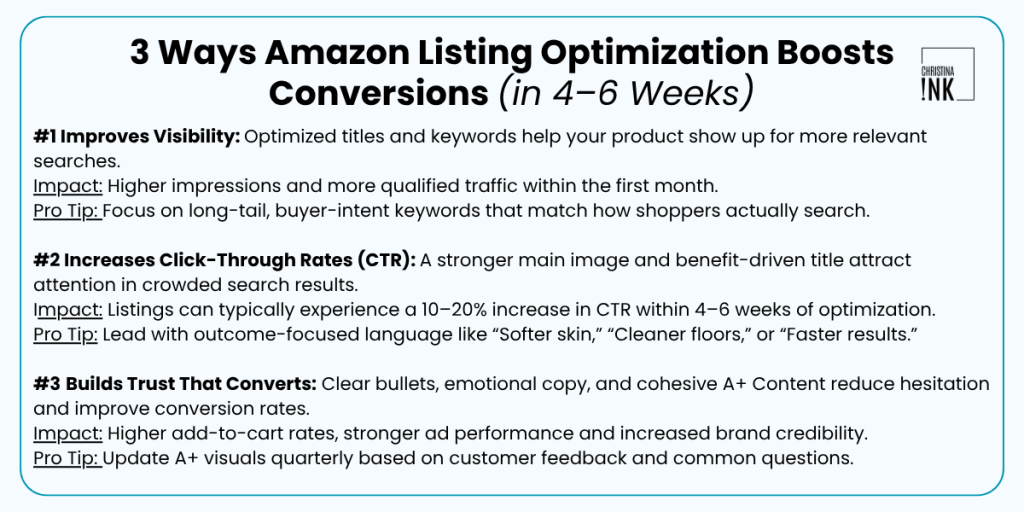When you hear the term Amazon listing optimization, it often comes packaged with big promises, skyrocketing rankings, instant conversions and products that seem to sell themselves overnight. But while those expectations sound great, they rarely align with reality.
The truth is, Amazon listing optimization is powerful, but it’s not magic. It’s a process grounded in buyer psychology, data analysis and ongoing refinement. In this guide, I’ll share what sellers can realistically expect from listing optimization in 2025 and why it matters more than ever for building a sustainable brand.
What Amazon Listing Optimization Actually Does
Amazon listing optimization ensures that every piece of your product detail page title, bullets, images, Amazon Brand Story, A+ Content and Amazon SEO works together to attract the right customer and convert them. A well-optimized listing can:
-
Improve visibility in relevant search results with strategic keyword placement
-
Increase click-through rates through stronger titles and main images
-
Build trust and conversions with benefit-driven copy and visuals
What optimization can’t do is fix low demand, poor reviews, or an uncompetitive product. Optimization amplifies potential. it doesn’t create interest out of thin air.
The Results You Can Expect (And When)

You can begin to see subtle but meaningful shifts within 4–6 weeks, depending on their category and competition. You might notice higher impressions, more clicks and a smoother ad performance curve.
But expecting a leap to page one overnight is unrealistic. Amazon’s algorithm needs time to respond to updates, and factors like sales velocity, pricing and reviews still play major roles. Here’s what you can expect from smart optimization:
-
Improved keyword relevance and organic visibility
-
Stronger ad-to-listing alignment (which improves ROAS)
-
Gradual gains in conversions and brand credibility
Listing optimization is less about chasing rank and more about creating resonance. When you focus on clarity, psychology and data, not shortcuts you build listings that win for years, not weeks. — Christina Passmore, Founder of Christina Ink
Why Some Listings See Big Gains And Others Don’t
Amazon Listing optimization doesn’t exist in a vacuum. It’s influenced by external factors like product-market fit, customer sentiment and how competitive your category is. A product in a low-competition niche with decent reviews might see dramatic results from optimization alone. But a highly saturated product with poor reviews and aggressive pricing wars? Amazon Listing optimization in 2025 can only take it so far.
If you’re not investing in advertising, building reviews, or driving traffic externally, your listing may never get the visibility it needs for optimization to truly shine. The listing can be perfect, but if no one sees it, the results will remain stagnant.
Why Iteration Matters More Than Perfection

Don’t treat listing optimization as a one-and-done task. In reality, it’s a living process. What resonates today might underperform six months from now. Competitors evolve. Shopper behavior shifts.
Treat optimization like a feedback loop, reviewing metrics, monitoring customer questions and testing creative updates regularly. Small, consistent improvements lead to steady growth; massive overhauls once a year rarely do.
Setting Expectations When Hiring an Agency
If you’re working with a listing optimization agency, go in with a clear understanding of what they can and cannot do. A good agency should not only conduct in-depth keyword and competitor research, but also take the time to understand your brand’s voice, values and positioning.
Carving out a cohesive brand identity on Amazon is essential to standing out, especially in saturated categories. A strong agency can help you define or refine your brand messaging and ensure it comes through clearly and consistently across your listings, A+ Content and Storefront. They should also
- Build a listing based on both algorithmic relevance and buyer psychology
- Provide creative direction for imagery, if not full execution
- Set realistic expectations around timelines and performance
But they can’t:
- Guarantee page-one rankings
- Fix underlying product issues (like low review scores or quality concerns)
- Drive traffic to your listing without a broader marketing strategy
Ask Amazon listing optimization services how they interpret performance and how often they recommend updating content. If they promise instant results, that’s a red flag.
What Real Success on Amazon Looks Like
Success from listing optimization doesn’t always mean a tenfold jump in sales. Sometimes, it means your PPC becomes more profitable because your listing converts better. Other times, it means fewer returns because your bullets better set expectations. Or maybe your organic ranking improves slightly, giving your ads more lift and your product more exposure.
The goal is not perfection. It’s progress. If every part of your listing is clearer, more aligned with your ideal customer, and rooted in actual data, then you’re winning—regardless of how dramatic the shift looks on the surface.
Top Amazon Listing Optimization Trends for 2025
The best-performing listings this year share one trait: they’re designed for how shoppers browse today.
-
Mobile-first structure. Over half of Amazon traffic comes from phones. Top listings front-load benefits, use shorter titles, and rely on visuals that communicate instantly.
-
Conversational SEO. Phrasing matters as much as volume. Sellers who use shopper language (“best protein snack for travel”) outperform those who keyword-stuff. For a deeper look at how real shoppers talk, ask and search on community platforms, read our companion post: Reddit Marketing For E-Commerce Sellers: How to Win Without Getting Burried
-
Emotionally intelligent copy. Great listings make customers feel understood before they buy. Address objections, use relatable imagery and write like a human.
-
Video integration. UGC-style demos, unboxings and quick explainer videos build trust and drive engagement.
-
AI and voice-readability. Listings that read naturally aloud and structure content clearly are already performing better in voice search results.
Amazon’s algorithm continues to reward total experience, not just keywords. The listings that convert best are cohesive, visually engaging and emotionally resonant.
Should I Create My Own Amazon List or Hire an Agency?

Should you handle Amazon listing optimization 2025 yourself, or bring in an expert? The answer depends on your time, skillset and goals.
If you choose the DIY route, there are fantastic tools and resources available. For keyword research, platforms like Helium 10 and Data Dive give you insights into what shoppers are searching for. Tools like Canva or Figma can help with visual planning and Amazon’s Brand Registry offers built-in A/B testing tools to test your title or images. For analyzing your results, Brand Analytics and Search Query Performance reports give you valuable feedback.
But optimization isn’t just about having tools. It also requires specific skill sets strong writing ability, a deep understanding of SEO, a feel for customer psychology and an eye for visual branding. You need to be able to distill product features into compelling, benefit-driven language. You need to know how to structure a listing for mobile shoppers. And you need to keep up with algorithm changes and conversion trends. That’s a lot to juggle.
Hiring an agency, especially one that specializes in Amazon listing optimization, means you don’t have to learn everything from scratch. A good agency brings process, perspective and clarity. They’ve tested what works. They know how to structure a listing from top to bottom. And they can help you define your voice and carve out a niche in a crowded market.
If you’re a newer seller on a tight budget, starting with DIY might make sense. But if your time is limited, or your brand is growing fast and you want to compete at a higher level, working with a partner like Christina Ink can save you months of trial and error.
At the end of the day, your product listing is your storefront. If it doesn’t connect, it won’t convert. Whether you do it yourself or hand it off to a team of experts, the goal is the same—clarity, trust, and compelling content that makes buyers say “yes.” If you’re ready to take the guesswork out of optimization, we’re here to help.
Amazon Listing Optimization 2025 Is A Critical Lever, Not A Silver Bullet
When approached with the right expectations, it can improve your visibility, increase conversions and support your overall growth strategy. But it works best when paired with strong fundamentals: a good product, solid reviews and ongoing marketing support.
At Christina Ink, we specialize in listings that convert because they connect. Not just to algorithms, but to people. If you’re ready to optimize not just for clicks but for real customer resonance, we’re here to help.
Frequently Asked Questions About Amazon Listing Optimization
Q: How long does it take to see results from listing optimization?
A: Most sellers notice measurable improvement within 4–6 weeks, but steady growth continues as your listing gains traffic and reviews.
Q: Can listing optimization fix poor sales?
A: Not if the product has low demand or weak reviews. Optimization enhances visibility, it can’t replace product quality or competitiveness.
Q: What’s the biggest mistake sellers make with optimization?
A: Treating it as a one-time task. Amazon’s marketplace evolves fast, so listings need ongoing testing and updates.
Q: How often should I update my listing?
A: Review your performance metrics quarterly and refresh content at least twice a year to stay aligned with shopper trends.
Q: Do I really need A+ Content and video?
A: Yes. Shoppers expect rich visuals. A+ Content and short videos boost trust, engagement and time on page.
Q: Should I hire an agency or do it myself?
A: If you have time and the right tools, DIY can work. But an experienced agency accelerates results and helps your brand stand out faster.

Christina Passmore
CEO, Christina Ink
Christina Passmore helps Amazon sellers and agencies scale through content strategy, marketplace optimization and positioning. A former Amazon seller, she brings deep knowledge of Amazon listing optimization, account health, marketplace trends, and seller growth. When she’s not writing or analyzing listings, you’ll find her exploring the Rockies or working through a CrossFit WOD.

LIKE THIS ARTICLE?